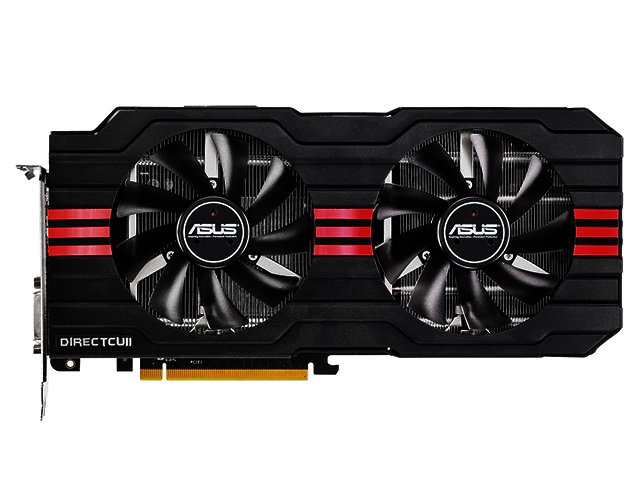PREVIOUS ARTICLENEXT ARTICLE
GIZMOS

Quick review - Asus Radeon HD 7950
By Hanleigh Daniels 7 February 2013 | Categories: gizmos
The Radeon HD 7950 is the second graphics card, after the range-topping (and more expensive) HD 7970, to feature AMD’s 28 nm GPU architecture, aiming to topple rivals such as Nvidia’s GeForce GTX 670.
Like Nvidia, who replaced its 40-nanometer (nm) Fermi GPU architecture with the new 28 nm Kepler process technology, AMD succeeded its 40 nm Cayman technology with a 28 nm Graphics Core Next (GCN) process, promising gains both in performance and power efficiency.
In order to make good on these promises, the Radeon HD 7950 sports a whopping 3 GB worth of GDDR5 RAM, and a 900 MHz engine clock that is 100 MHz over and above the standard reference clock for AMD’s Radeon HD 7950. The GPU’s dual fan DirectCU thermal setup ensures that the card stays cool, providing a 20% cooling performance improvement in fact according to Asus and also enabling significantly quieter airflow. We can report that the fans remained quiet even during benchmarking and extended gaming sessions, keeping our attention on the game rather than a constant drone emanating from the PC case.
In terms of connectivity, the card is set for DVI-I, full HDMI, and two mini display ports, with a miniDP to DVI adaptor included in the retail package.

This GPU monster is a bit of a PC case space hog, so we just barely got it into our standard PC case.
Less power, more performance
When it comes to power, this massive (300 x 129 x 58 mm) beast of a GPU is less of a power hog compared to its bigger brother – the Radeon HD 7970 – which requires one 8-pin (150 W) and one 6-pin (75 W) PCI Express power connectors.
Like the GeForce GTX 680 (review), the 7950 only needs two 6-pin PCI Express power connectors from a 550 W power supply unit (PSU). This total is 50 Watt more than the standard reference from AMD for its Radeon HD 7950, with the faster engine clock and enhanced cooling setup costing users in terms of the size of the PSU needed to feed this GPU beast (and also meet your PC’s needs). In terms of space, the Radeon HD 7950 is actually bigger than the HD 7970 (276 x 106 x 33 mm), so although it won’t be as taxing on your PSU as its bigger brother in the 7900 Series it will be annexing some additional PC case space.
Beyond the power efficiency gains enabled by the GCN architecture, performance also gets a shot in the arm. Not only does the 7950 offer blistering frame rates at the highest resolutions and maximum quality settings for less GPU taxing titles such as Batman: Arkham Asylum GOTY edition and PES 2013 (review) through to more demanding titles the likes of Crysis 2 (review) and Rage. It also dishes up some impressive tallies during benchmarking, delivering a fantastic score of 1874 within Heaven Benchmark 2.0, whilst a score of 2300 was obtained via Futuremark’s 3DMark 2011 DX11 benchmark test (using the extreme pre-sets). Test were performed on a PC sporting 8 GB of 1600 MHz RAM, 750 Watt Corsair PSU and Intel Core i5-3570K CPU.

The bigger they are the harder they perform appears to be the case with the massive Radeon HD 7950 (top) and Radeon HD 6950 (bottom).
To the point
Asus’ Radeon HD 7950 GPU offers a significant amount of GPU bite for its equally potent RRP bark of R5 000. Its performance wasn’t worlds away from the more expensive (R6 200) GeForce GTX 680, whilst being less demanding on power than the Radeon HD 7970.
Pros:
Fantastic boost to your PC’s gaming and overall performance.
Dual-fan setup does stellar job of keeping the card cool.
Uses less power than the Radeon HD 7970.
Cons:
Costs as much as a well-specced entry-level PC.
Large size GPU takes up a lot of space within the PC case.
USER COMMENTS
Most Read Articles
Read

Magazine Online
TechSmart.co.za is South Africa's leading magazine for tech product reviews, tech news, videos, tech specs and gadgets.
Start reading now >
Download latest issue
Have Your Say
What new tech or developments are you most anticipating this year?
New smartphone announcements (44 votes)
Technological breakthroughs (28 votes)
Launch of new consoles, or notebooks (14 votes)
Innovative Artificial Intelligence solutions (28 votes)
Biotechnology or medical advancements (22 votes)
Better business applications (133 votes)



